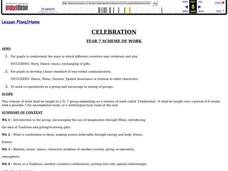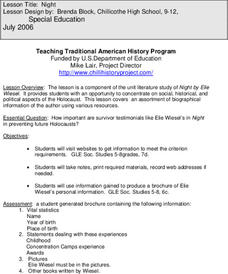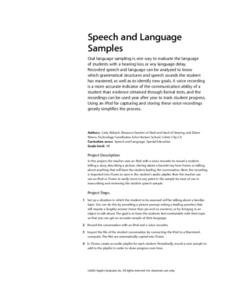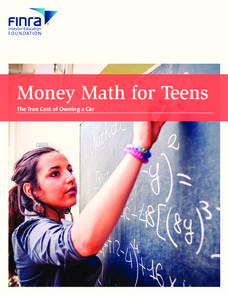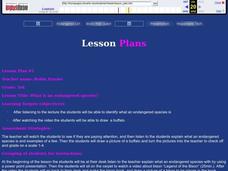Curated OER
All About Penguins
Second graders research penguins. In this all about penguins lesson, 2nd graders identify facts from their readings and write an expository paper using proper capitalization and punctuation.
Curated OER
Celebration
Students identify the different ways in which different countries celebrate and why, including story, dance, music, and exchanging gifts. Then they develop a basic standard of non-verbal communication through either dance, mime,...
Curated OER
Using a Questionnaire as a Tool for Management
Students survey other students, teachers, and administrators, using a provided questionnaire, to see what environmental problems the school may have. Students then compile the results, post the results, and decide what the biggest...
Curated OER
Night
Students read Night by Elie Wiesel, examine importance of survivor testimonials like Wiesel's in preventing future Holocausts, research biographical information online about Wiesel, and create author brochure including vital statistics,...
Curated OER
The Dinosaur Diner
Students explore the food chain. In this dinoaur lesson, students identify charactersitics of an omnivore, carnivore, and herbivore. Students sort dinosaur picture/word cards into groups by their eating characteristics. Students also...
Curated OER
Open Sesame: A Magical World of Reading
Third graders, through six lessons, study tales of Ali Baba and the Forty Thieves and Aladdin and the Lamp from The Arabian Nights.
Curated OER
Speech and Language Samples
Learners tell a story, describe a picture, share about a favorite toy from home and are recorded using an iPod with a voice recorder. They create a playlist of their voice and reading samples to illustrate progression over time.
Curated OER
The Giving Tree
Fourth graders participate in a shared reading of The Giving Tree. They discuss the relationship between trees and people in the story. Students contribute to a class KWL chart. They create their own KWL chart with at least four things...
Curated OER
Progressives Perspectives
Eleventh graders consider the case for Progressive politics. In this Progressive Era lesson plan, 11th graders read excerpts from The Jungle as well as articles about the Triangle Shirtwaist Factory fire. Students also analyze...
Curated OER
Civil Rights
Twelfth graders survey how controversial court cases have changed the viewpoints of civil rights. In this U.S. Government lesson plan, 12th graders work in small groups to prepare summaries of specific court cases, then present...
Curated OER
Introduction to the Internet
Second graders are introduced to basic Internet navigation. They access Yahooligans and work in pairs to explore sites. Students use the "back" button, scroll up and down a screen and practice opening Netscape.
Curated OER
You Can Stop!!
Students analyze smoking behavior based on peer pressure. In this health lesson, students read and complete worksheets on the internet concerning the behaviors associated with smoking. They summarize what they have learned by...
Curated OER
Blogging to Create a Community of Writers #1: Setting Up the Blog
Writer's workshop is an idea that's been around for years. Students write, read, and comment on each others writing in an authentic and thoughtful way. Here is a 21st century twist, 6th graders will use the class blog to create a...
New York City Department of Education
Egypt
This six-week unit encompasses all subjects with a focus study on world history and the development of ancient civilizations. As gifted and talented students dive into the interesting yet challenging topic of Egypt, they...
Curated OER
Task: Range of Motion
If you have ever injured your shoulder, you know it takes a while to improve your arm's range of motion. In this real-world example, young mathematicians gain insight into the world of physical therapy while they analyze a case study...
Inside Mathematics
Population
Population density, it is not all that it is plotted to be. Pupils analyze a scatter plot of population versus area for some of the states in the US. The class members respond to eight questions about the graph, specific points and...
American Chemical Society
Investigating the Line
Note that this lesson is best paired with the preceding lesson in the unit. In that lesson, elementary physical scientists observed that the color coating of M&Ms® candies do not mix when dissolved off of the chocolate surface. Now...
University of California
Student Workbook: Reading Comprehension
Teach your class five reading strategies to help them with reading informational texts and literary texts. This packet, designed to help learners prepare for the CAHSEE, provides specific strategies that could be used to help prepare for...
Inside Mathematics
Winning Spinners
Winning a spin game is random chance, right? Pupils create a table to determine the sample space of spinning two spinners. Individuals determine the probability of winning a game and then modify the spinners to increase the probability...
SaveandInvest.org
The True Cost of Owning a Car
Almost every teen wants a car, but can they really afford one? The lesson walks pupils through how to identify a budget, find all of the costs associated with car ownership, and determine if they should buy the car or keep looking.
Curated OER
Build Your Dream Bedroom
Designers measure their own rooms and produce a scale drawing. They use the Internet to visit sites to find the costs of purchasing new carpet, paint, or anything else they would like to add to their room. Using a $1500 budget, they will...
Curated OER
Career Magic
Fifth graders gather information about the roles, responsibilities, skills, and training and education requirements of workers. Then they input this information into a graphic organizer chart and identify the similarities and differences...
Curated OER
What is an Endangered Species?
Here are two well-designed, and easy-to-follow lesson plans on endangered species for your third graders. The focus is on the bison; the history of the slaughter of the animals in the 1800's, and the story of how they were saved from...
Curated OER
Box It Up
Students use a six-step problem solving method to design a box/container. They are given the criteria for evaluation when presented with the problem. Students keep a notebook on processes, procedures, material, cost, design, machines,...

